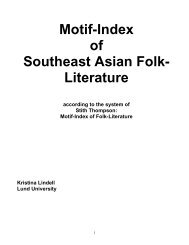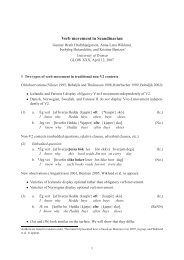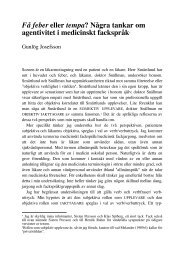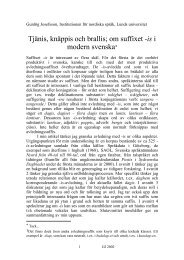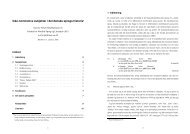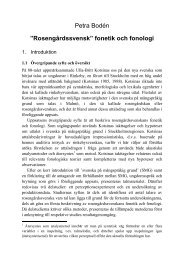Non-Nominative Subjects in Old and Middle Danish
Non-Nominative Subjects in Old and Middle Danish
Non-Nominative Subjects in Old and Middle Danish
You also want an ePaper? Increase the reach of your titles
YUMPU automatically turns print PDFs into web optimized ePapers that Google loves.
G. Hr. Hrafnbjargarson XVIth International Conference on Historical L<strong>in</strong>guistics<br />
(13) MD. Honum thøkte [ sek vara i en<br />
Him-DAT thought REFL be <strong>in</strong> a<br />
’He thought that he was <strong>in</strong> a wonderful town’<br />
lysteligen<br />
wonderful<br />
stath ]<br />
town<br />
(1425, SJTR)<br />
2.3 Conjunction Reduction<br />
In modern Sc<strong>and</strong><strong>in</strong>avian (MSc <strong>and</strong> ISc), the subject <strong>in</strong> the last of two conjo<strong>in</strong>ed sentences can<br />
be omitted. In such context, the object cannot be omitted:<br />
(14) Da. a. I dag læste<br />
Today read<br />
jeg en<br />
I-NOM a<br />
brev<br />
letter<br />
’Today, I read a book <strong>and</strong> wrote a letter’<br />
bog og [e] skrev et<br />
book <strong>and</strong> wrote a<br />
b. *Denne bog f<strong>and</strong>t jeg og [e] købte jeg med<br />
This book found I-NOM <strong>and</strong> bought I-NOM with<br />
det samme<br />
the same<br />
If <strong>Old</strong> <strong>and</strong> <strong>Middle</strong> <strong>Danish</strong> behaved <strong>in</strong> the same way as Modern <strong>Danish</strong>, i.e. that only subjects<br />
can be omitted, oss ’us’ <strong>in</strong> (15) must be the subject for both lighe ’like’ <strong>and</strong> noghe ’be content<br />
with’: 4<br />
(15) MD. ... ladæ [ oss lighe ok [e] noghæ meth thet ]<br />
... let us-OBL like <strong>and</strong> be content with it<br />
’... let us like it <strong>and</strong> be content with it’ (1407) 5<br />
This example is however not completely unproblematic. First of all, it is <strong>in</strong>convenient<br />
that the subjects of both conjo<strong>in</strong>ed clauses are oblique subjects. It is known from German<br />
(cf. Eythórsson & Bardal 2003:174 <strong>and</strong> references there) that subject-like datives <strong>and</strong> accusatives<br />
can be omitted <strong>in</strong> the last of two conjo<strong>in</strong>ed sentences if there is a subject-like dative<br />
or accusative <strong>in</strong> the first of two conjo<strong>in</strong>ed sentences. Accord<strong>in</strong>g to Eythórsson & Bardal<br />
(2003:175) the same holds for nom<strong>in</strong>ative subjects <strong>in</strong> German, i.e. nom<strong>in</strong>ative subjects can<br />
only be omitted if the subject of the first clause is nom<strong>in</strong>ative. Eythórsson & Bardal (2003)<br />
take this fact not to weaken Conjunction Reduction as a subjecthood test, rather they take it to<br />
proove the existance of oblique subjects <strong>in</strong> German.<br />
4 The verb nøjes ’be content with’ also assigned oblique case to its subject:<br />
(i)<br />
Da. Hun har alt det, mig k<strong>and</strong> nøje<br />
She has all that me-OBL can be content with<br />
’She has everyth<strong>in</strong>g that I can be content with’<br />
(1648, ASC I.178)<br />
5 26/2 1407 (Rosk,Rep.4882;i vid, 25/5 1414 kanc.).(bisp el.)kanc.;<br />
København, August 11, 2003 5 of 12



